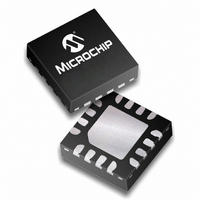PIC16F688-I/ML Microchip Technology, PIC16F688-I/ML Datasheet - Page 38

PIC16F688-I/ML
Manufacturer Part Number
PIC16F688-I/ML
Description
IC PIC MCU FLASH 4KX14 16QFN
Manufacturer
Microchip Technology
Series
PIC® 16Fr
Datasheets
1.PIC16F616T-ISL.pdf
(8 pages)
2.PIC16F688T-ISL.pdf
(204 pages)
3.PIC16F688T-ISL.pdf
(6 pages)
4.PIC16F688T-ISL.pdf
(4 pages)
5.PIC16F688T-ISL.pdf
(688 pages)
6.PIC16F688-IML.pdf
(202 pages)
Specifications of PIC16F688-I/ML
Program Memory Type
FLASH
Program Memory Size
7KB (4K x 14)
Package / Case
16-QFN
Core Processor
PIC
Core Size
8-Bit
Speed
20MHz
Connectivity
UART/USART
Peripherals
Brown-out Detect/Reset, POR, WDT
Number Of I /o
12
Eeprom Size
256 x 8
Ram Size
256 x 8
Voltage - Supply (vcc/vdd)
2 V ~ 5.5 V
Data Converters
A/D 8x10b
Oscillator Type
Internal
Operating Temperature
-40°C ~ 85°C
Processor Series
PIC16F
Core
PIC
Data Bus Width
8 bit
Data Ram Size
256 B
Interface Type
EUSART/RS- 232/SCI/USB
Maximum Clock Frequency
20 MHz
Number Of Programmable I/os
12
Number Of Timers
2
Maximum Operating Temperature
+ 85 C
Mounting Style
SMD/SMT
3rd Party Development Tools
52715-96, 52716-328, 52717-734
Development Tools By Supplier
PG164130, DV164035, DV244005, DV164005, PG164120, ICE2000, DM163014, DM164120-4
Minimum Operating Temperature
- 40 C
On-chip Adc
8-ch x 10-bit
Lead Free Status / RoHS Status
Lead free / RoHS Compliant
For Use With
AC164324 - MODULE SKT FOR MPLAB 8DFN/16QFNXLT16QFN1 - SOCKET TRANSITION 14DIP TO 16QFNAC162061 - HEADER INTRFC MPLAB ICD2 20PINAC162056 - HEADER INTERFACE ICD2 16F688
Lead Free Status / Rohs Status
Lead free / RoHS Compliant
PIC16F688
4.2.4
The Ultra Low-Power Wake-up (ULPWU) on RA0
allows a slow falling voltage to generate an interrupt-
on-change on RA0 without excess current consump-
tion. The mode is selected by setting the ULPWUE bit
of the PCON register. This enables a small current sink
which can be used to discharge a capacitor on RA0.
To use this feature, the RA0 pin is configured to output
‘1’ to charge the capacitor, interrupt-on-change for RA0
is enabled, and RA0 is configured as an input. The
ULPWUE bit is set to begin the discharge and a SLEEP
instruction is performed. When the voltage on RA0
drops below V
will cause the device to wake-up. Depending on the
state of the GIE bit of the INTCON register, the device
will either jump to the interrupt vector (0004h) or
execute the next instruction when the interrupt event
occurs.
CHANGE” and Section 11.3.3 “PORTA Interrupt” for
more information.
This feature provides a low-power technique for
periodically waking up the device from Sleep. The
time-out is dependent on the discharge time of the RC
circuit on RA0. See Example 4-2 for initializing the
Ultra Low-Power Wake-up module.
The series resistor provides overcurrent protection for
the RA0 pin and can allow for software calibration of the
time-out. (see Figure 4-1). A timer can be used to
measure the charge time and discharge time of the
capacitor. The charge time can then be adjusted to
provide the desired interrupt delay. This technique will
compensate for the affects of temperature, voltage and
component accuracy. The Ultra Low-Power Wake-up
peripheral can also be configured as a simple
programmable low voltage detect or temperature sensor.
DS41203E-page 36
Note:
See
ULTRA LOW-POWER WAKE-UP
For more information, refer to Application
Note AN879, “Using the Microchip Ultra
Low-Power
(DS00879).
IL
, an interrupt will be generated which
Section 4.2.3
Wake-up
“INTERRUPT-ON-
Module”
EXAMPLE 4-2:
BANKSEL PORTA
BSF
MOVLW
MOVWF
BANKSEL ANSEL
BCF
BANKSEL TRISA
BCF
CALL
BSF
BSF
BSF
MOVLW
MOVWF
SLEEP
NOP
PORTA,0
H’7’
CMCON0
ANSEL,0
TRISA,0
CapDelay
PCON,ULPWUE ;Enable ULP Wake-up
IOCA,0
TRISA,0
B’10001000’ ;Enable interrupt
INTCON
ULTRA LOW-POWER
WAKE-UP INITIALIZATION
© 2009 Microchip Technology Inc.
;
;Set RA0 data latch
;Turn off
; comparators
;
;RA0 to digital I/O
;
;Output high to
; charge capacitor
;Select RA0 IOC
;RA0 to input
; and clear flag
;Wait for IOC
;



















